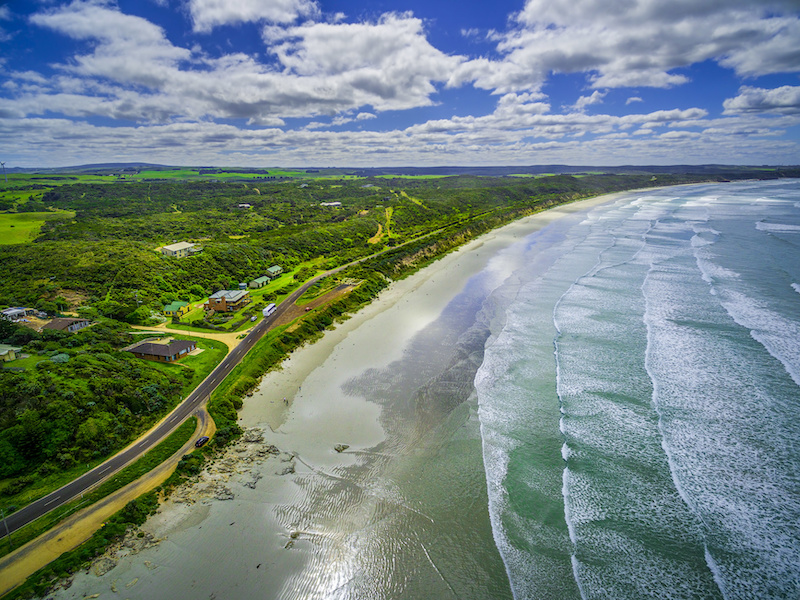While many people tend to think of landscape photography as being specific to the photography of mountains, hills, grasslands, and many other types of terrain, it is a broad category, with many subcategories falling underneath.
as being specific to the photography of mountains, hills, grasslands, and many other types of terrain, it is a broad category, with many subcategories falling underneath.
One of the most popular subcategories– and the main topic of this article– is seascape photography . Let’s look at just what seascape photography is and review some of the best micro four-thirds lenses to use.
. Let’s look at just what seascape photography is and review some of the best micro four-thirds lenses to use.
What is Seascape Photography?
Essentially, seascape photography is any form of photography of the sea and all of the elements surrounding it.
Your average seascape scene could range from a warm sandy beach with turquoise-colored water to grey clouds, dark and raging ocean water, and misty shorelines.
However, perhaps the most popular type of seascape shot to capture is one taken at the golden hour, either sunrise or sunset.
But the general idea of seascape photography is the same no matter the weather– you’re shooting images of the sea/ocean and all the elements around it.
Since there are many factors to consider in shooting seascape photography that you don’t find in street photography or general travel photography
or general travel photography – such as location, weather, time, tide, and lighting– it can be a bit of a challenging niche of photography.
– such as location, weather, time, tide, and lighting– it can be a bit of a challenging niche of photography.
That’s where having a great camera system, the right equipment, ideal conditions come into play. Below I’ve listed a few essential pointers to remember when starting with seascape photography:
- Safety first. Finding the perfect angle and composition often means walking through wet sands, climbing over sharp and slippery rocks, and venturing to areas where most people don’t go. Make sure you wear slip-resistant shoes and carry a water-resistant bag with you to store all your gear in.
- Observe the tide. Whether the tide is low or high will determine which places are reachable or unreachable. If you’re looking to shoot from a hard-to-reach location, it may be best to wait until low tide sets in. However, some of the best shots are taken during high tide, so it all depends on your location and what kind of result you’re aiming for.
- Use a tripod. Even though your camera most likely has image stabilization, it is absolutely essential for you to shoot using a tripod to reduce any noise in your photos, especially when experimenting with longer exposures.
- Bring microfiber cloths. Since you’ll be getting up close and personal with the water, your lens is likely to be hit by a splash or two every now and then. To preserve your lens and avoid damage, bring microfiber cloths just in case.
- Try weird angles and perspectives. Often in photography, the best photos taken are the result of trying something new and unique. Instead of taking a photo of the seascape straight on (where the horizon and everything is perfectly horizontal and balanced), try experimenting with different angles and compositions, such as shooting from a higher angle or lower angle. These unique perspectives bring new life to the location you’re shooting at.
Why Micro Four Thirds For Seascape Photography
The first Micro Four Thirds system was invented in 2008 as a joint effort by Olympus and Panasonic.
was invented in 2008 as a joint effort by Olympus and Panasonic.
As the first in the history of the mirrorless revolution, the Micro Four-Thirds (M43 or MFT) is the predecessor for today’s APS-C sensors, but it is still the camera system of choice for many photographers, and it makes sense.
The M43 system offers the perfect blend of portability and power, with many features to provide for the money.
While the first Micro Four-Thirds cameras sported a mere 12-megapixels of resolution, many of today’s more advanced M43 cameras offer up to 20-megapixels, allowing you to create some enormous prints of your seascape photos.
The M43 system also comes equipped with IBIS (In Body Image Stabilization), which is very handy when shooting seascape photography, or even wildlife and street photography for that matter.
The image stabilization feature allows you to capture shake-free shots in low light conditions and shoot at slower shutter speeds.
Some other features that an M43 system has that make it perfect for seascape photography include faster processing and autofocus speeds (which allow you to capture those fleeting moments of perfect lighting and composition), and of course, convenient portability so you can carry the camera along the shoreline as you scope out the perfect location for your shots.
Overall, the M43 system offers a lightweight yet feature-rich camera that’s capable of taking impressive seascape photos.
How to Choose the Lens For Seascape Photography
As somewhat of a subcategory of landscape photography, the preferred lens to use for seascape photography is not much different from those used for landscape photography in terms of features.
However, for good measure, let’s still take a look at some of the most important factors to consider when choosing your lens:
Focal Length
For landscape and seascape photography, you should always use a wide-angle or ultrawide-angle lens. These lenses will allow you to capture more elements in your photos without suffering in quality.
Since M34 systems have a 2x crop factor (which doubles the lens focal length), you’ll be better off buying an ultra-wide-angle lens for seascapes. However, a wide-angle lens can be just as effective if used properly.
Portability
Since M34 systems and lens are already lightweight , you’ll have no trouble with portability. This is important as it allows you to carry your gear easily as you trek to find the right location to shoot.
, you’ll have no trouble with portability. This is important as it allows you to carry your gear easily as you trek to find the right location to shoot.
Small Aperture
A smaller aperture allows you to capture a deeper depth of field in your image, meaning everything in the foreground and the background will be equally sharp and in focus.
You definitely want a smaller aperture so everything in your seascape photos is crisp and clear.
Weather Protection
Since you’ll be working in close proximity with elements like ocean water and sand/debris, having proper weather protection is important.
However, this isn’t too much of a concern, since most lenses come with a special casing and a cover for the front of the lens.
The Best M43 Lenses for Seascape Photography
Without further ado and with those factors in mind, let’s take a look at some of the best micro four-thirds lenses to use for seascape photography:
Olympus M.Zuiko 7-14mm f/2.8 Pro

This lens is easily the best lens for seascape photography. It is an ultra-wide lens that features the full-frame equivalent of 14mm FOV (field of view), a very nimble f/2.8 aperture, and a weather-resistant casing.
This makes this lens perfect for shooting seascape photography, which involves constant exposure to saltwater and the elements.
It is priced fairly high, but the price is well worth it for the quality and durability you’re getting.
Overall, this lens is a tank that can handle all the needs of seascape photography without fail. It certainly has served me well.
Panasonic Lumix G Vario 7-14mm f/4

As the only rectilinear (non-image-warping) ultra-wide-angle lens offered by Panasonic, the Panasonic Lumix G Vario 7-14mm f/4 is another great lens for any seascape photographer.
Weighing in at a mere 10.4 ounces, the lens is still very capable of producing sharp images. Its smaller f/4 aperture doesn’t hurt either when it comes to capturing all the details of your scene.
However, it does not include weather sealing and filter capability, which are the only turn-offs. Even still, it is one of the best-performing lenses to consider for seascape photography.
Panasonic Leica DG Vario-Elmarit 8-18mm f/2.8-4

As one of the creators of the Micro Four-Thirds system, Panasonic knows how to make a solid M34 lens that’s great for seascape photography.
This wide-angle lens is very light (weighing in at only 11.1 ounces), reasonably inexpensive, and allows for the use of filters.
Considering that it is cheaper than most competitors while still being capable of producing premium-quality images, it is a solid choice for all levels of seascape photography.
Olympus M.Zuiko 12-100mm f/4 Pro

Rather than being either a portrait or ultra-wide lens, the 12-100mm f/4 Pro is an all-in-one lens that is very capable at both ends of the spectrum.
This makes it an ideal lens for seascape photography as well as wildlife, travel, portrait, and street photography demands.
While many other all-in-one lenses tend to lack in quality at some point, this lens is very impressive throughout its entire zoom range and even does well in low light conditions.
However, as can be expected of an Olympus Pro series lens, the 12-100mm f/4 is relatively pricey.
And while it performs exceptionally well, it still is no match for a specialty wide-angle (such as the Panasonic 8-18mm f/2-8.4) or portrait lens in terms of quality.
Even still, it is a perfect lens to consider if you’re looking for a powerful option that can deliver in most seascape situations.
Olympus M.Zuiko Digital ED 14-42mm f/3.5-5.6 EZ

If you’re looking for a cheaper yet very effective wide-angle lens, the Olympus 14-42mm f/3.5-5.6 EZ is an excellent choice for starters.
It works surprisingly well in a wide range of seascape shooting conditions and performs just as well for travel and wildlife photography . As a pancake lens, this lens is also extremely portable while not lacking in durability.
. As a pancake lens, this lens is also extremely portable while not lacking in durability.
The Olympus 14-42mm f/3.5-5.6 EZ was one of the first lenses I used for seascape photography, and I still keep it in my arsenal for lighter travel itineraries.
In Closing
As you can see, seascape photography is a niche that is very unique and challenging in its own way, making it a very popular choice for many photographers.
There are many great lenses to choose from that will help you capture the perfect M43 seascape images.
Sure, some have advantages over others, but they are all great choices, no matter if you’re a novice or an expert in the field.
What really matters in seascape photography (and in photography in general) is that you remain creative, try new angles and ideas, and always challenge yourself to do better.


